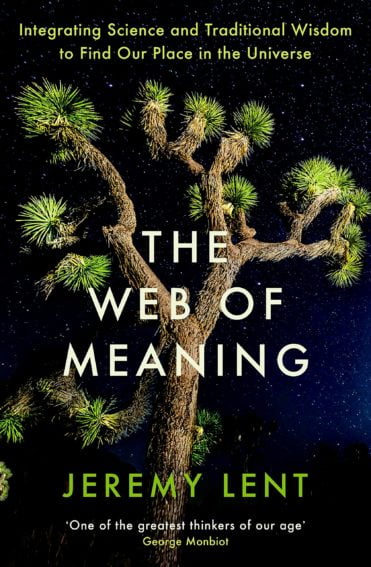
“The Web of Meaning: integrating science and traditional wisdom to find our place in the universe”, by Jeremy Lent, ventures into the speculative territory between science and religion in search of the origins of consciousness and humanity’s fall from grace. Along the way Lent, described on the cover by Guardian columnist George Monbiot as “…one of the greatest thinkers of our age”, assembles a fascinating collection of ideas that scientists have proposed to explain the big mysteries in neuroscience, cognitive psychology and biology, drawing parallels with the Tao Te Ching. The mistake Lent makes, however, is to present speculative ideas from the frontiers of multiple disciplines as established knowledge, rather than the untested or untestable hypotheses they are.
For example Lent claims that epigenetics ‘…simply refers to a form of inheritance that is not genetic’ (p.132). It doesn’t. Epigenetics refers to environmental influence on the way genes are copied, some of which is heritable. That a geneticist has suggested epigenetics be extended to include cultural inheritance does not change biology. Similarly Lent claims that Lamarckism – evolution through the heritability of characteristics acquired during a lifetime – has been ‘validated by science’ (p.154). It hasn’t, as geneticist Massimo Pigliucci explains.
This book ultimately begs the question: is it possible, necessary or meaningful to integrate science and traditional wisdom? Palaeontologist Stephen Jay Gould attempted to resolve this by classifying science and religion as ‘non-overlapping magisteria’; two separate realms of human experience with no common ground. While Science documents the factual character of the natural world and theories that explain these facts, religion operates in the realm of purpose, meaning, and value, subjects which science might illuminate but can never resolve.
The problem is that science and religion inevitably do overlap whenever they make competing claims about the same phenomenon, such as the diversity and origin of life.
Until the second half of the 19th century, most scientists believed that the staggering diversity of life on Earth was the work of God. So Charles Darwin thought, at the age of twenty two when he left Plymouth on the Beagle in 1831. His theory of natural selection, shaped by what he saw on that voyage and what he read in Charles Lyell’s Principles of Geology, proposed instead that the huge diversity of living things was driven by life’s constant need to adapt to a changing Earth.
After ‘On the Origin of Species’ was published, God could still be invoked to explain how life began, but was no longer necessary to explain its diversity.
Lent comes unstuck again when he claims that vitalism has been scientifically validated (p. 154). It hasn’t and it can’t be. Vitalism is belief in a life force beyond the physical world, and science can never validate the existence of a concept beyond the reach of our senses. While science can never validate vitalism, it could disprove it if there is ever a physical explanation for the emergence of life from matter.
A hundred and sixty years ago, Thomas Huxley suggested that using vitalism to explain the origin of life is like saying the properties of water are due to its aquiosity. Inventing a new concept is not an explanation. As the chemical and physical nature of more and more vital phenomena have been demonstrated, vitalism has fallen out of favour and has not appeared in biology text books since the 1930s. The boundaries between science and religion are renegotiated whenever a physical explanation emerges for a phenomena that previously relied on a religious one.
Earlier attempts to draw parallels between science and Taoism have not fared well. In 1975 Austrian physicist Fritjof Capra published ‘The Tao of Physics: An Exploration of the Parallels Between Modern Physics and Eastern Mysticism’. The book sold over a million copies, was translated into 23 languages and helped to kick start the New Age non-fiction genre, but its timing was unfortunate.
At a meeting at Stanford University the month before ‘The Tao of Physics’ was completed, evidence emerged that overthrew the bootstrap theory – the basis of Capra’s book – in favour of the standard-model quantum field theory, following discoveries by Burton Richter and Samuel Ting, who were awarded the Nobel Prize the following year.
It was the standard model, based on the notion that the universe is composed of material particles and nothing more, that predicted the existence of the Higgs boson, which was first observed in 2012. In the view of physicist Peter Woit “The bootstrap philosophy, despite its complete failure as a physical theory, lives on as part of an embarrassing New Age cult, with its followers refusing to acknowledge what has happened.” (p.144)
For those inclined towards vitalism, this book offers the illusion of 500 pages of closely argued evidence supported by over 800 citations. But if you remain curious about life and the evolution of consciousness, Daniel Dennett’s ‘From Bacteria to Bach and Back’ is a useful antidote.
Traditional wisdom, religion and spirituality don’t need support from science. They are different ways of interpreting the world, existing on their own terms to be experienced on their own terms. Its where they overlap that things can get messy.
“The Web of Meaning: integrating science and traditional wisdom to find our place in the universe”, by Jeremy Lent, was published in 2022 by Profile Books (ISBN 978 1 78816 565 5).

